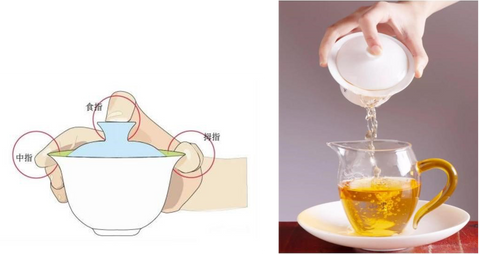
What is Gaiwan, the Past and Present
- The definition of gaiwan:
In the history of Chinese tea sets, gaiwan is a young utensil that is still widely used today.
Our common tureen generally has two shapes: the first one: In the "Chinese Tea Dictionary" by Academician Chen Zongmao, the tureen is explained as "cooking utensils, mostly porcelain, with a cover on the top and a saucer on the bottom, and the heat insulation of the saucer is easy to hold." drink". What is described here is a three-piece gaiwan-shaped system with a cover on the top, a support on the bottom, and a bowl in the middle. The cover is "heaven", the bowl is "person", and the support is "earth".
The three talents of "heaven, earth and man". This type of tureen is also called the Sancai Cup, which means "Three Talents, Heaven, Earth and Man". There is also a style of tureen, which is a two-piece bowl and cover-only the cover and the bowl. It is explained in the "Chinese Ancient Ceramics Illustrated": Gaiwan, a small bowl with a cover, tea set, popular in Qing Dynasty.
Whether it is a tureen composed of two parts, a bowl and a cover, or a tureen composed of three parts, a bowl, a cover, and a holder, it can meet people's needs for brewing and tasting tea in tea activities.
Here it needs to be mentioned that the combination of utensils with lids on the bowls existed in the Han Dynasty. After that, all dynasties have food utensils or storage utensils with lids.
They overlap with covered pots and even pots and kettles in terms of shape and function. This kind of utensils are also called covered bowls. with what we use and refer to on a daily basis
The "gaiwan" tea sets are similar in shape, but there is no obvious difference in decoration and materials, but there are significant differences in size and use.

- The development and evolution of Gaiwan
Gaiwan evolved from a single bowl, to a combination of bowl and bottom support, and finally to the composition of cover, bowl and support.
One person is for single use, and each person drinks tea with a tureen. Today, the tureen can not only be used by one person for drinking, but also can be used as the main brewing utensil.
So in this part, let's take a look at the development and evolution of Gaiwan。
Appeared in the Han Dynasty: a single bowl shape
Since the appearance of tea sets in the Han Dynasty, it has been a long time since tea sets have become daily utensils for ordinary people.
Later, until the Tang Dynasty, there was no strict boundary between tableware and drinking utensils. In most cases, the two were shared, that is, we would say that they had the same source of food at that time.
However, wine sets and tea sets, which are both drinking utensils, have been shared for a longer time. People's tea drinking habits in the Han Dynasty were relatively extensive, and a tea culture system had not been formed. Therefore, the requirements for drinking tea and tea sets were relatively high. Low-level, so at that time, only one bowl was needed to complete the action of drinking tea. Similarly, the shape of the bowl for drinking tea was relatively simple and rough, and it only appeared in the form of a single bowl.
- In the Tang Dynasty, bowl bases began to appear
There are more than 20 kinds of tea sets recorded in Lu Yu's "Tea Classic" in the Tang Dynasty. From this, it can be seen that the tea sets in the Tang Dynasty have appeared and are fully equipped. Tea sets are no longer the stage of the same diet, but have an independent system.
The prevalence of tea culture in the Tang Dynasty promoted the formation of the cup tray during this period. Why do you say that? In the Tang Dynasty, the popular tea drinking
The method is to make tea, which is to make tea balls from the tea leaves. When drinking, mash the tea balls and add ginger, orange peel, salt and other seasonings to cook together. After boiling the tea, it is necessary to separate the tea, and the temperature of the boiled tea is relatively high, and it is easy to burn the tea directly from the tea cup. The appearance of the cup holder is used as an accessory of the tea bowl.
On the one hand, the tea bowl with a cup holder can prevent the person passing the tea from touching the tea bowl directly, avoiding the hot problem of directly holding the tea bowl. On the other hand, it shows the respect and respect for the tea user when passing the tea bowl, showing the rank and dignity And China's unique tea drinking etiquette and culture.
In the "Yan Fanlu" of the Song Dynasty, the story of the creation of Zhantuo is recorded: Tuozhan began in Tang Dynasty, and there was nothing in the previous life. Cui
Ning Nv drank tea, warmed the sick cup and ironed her fingers, took a dish and melted the wax into a circle about the size of the cup, put the cup in the wax, and did not tilt it, because she ordered the craftsman to paint it (xiū qī). Ning likes to do it, and the name is called "Tuo", so he will practice it in the world.
Let's tell this story in vernacular: During the Jianzhong period, Cui Ning, the governor of Sichuan and governor of Chengdu at that time, had a daughter.
Son, when she was drinking tea with her father, she felt that it was very hot to directly serve the teacup, so she took a plate with snacks on the tea table and dragged it. However, since the cup has no fixed position in the plate, it is very easy to use. slip. This woman is very smart. In order to solve the problem that the teacup is easy to slip in the saucer, she dripped a ring in the center of the saucer with wax. Using the property of the wax to solidify after cooling, she made a fixed circle in the middle of the saucer and put the teacup in it. Then it just fits in the small circle, and the lamp is stable when in use. Afterwards, she asked the craftsmen to design and produce finished products that can be used for a long time according to this idea, and the bottom bracket in the tureen was created in this way.
The picture below shows the five dynasties secret color porcelain lotus bowl and cup support now in the Suzhou Museum, which were unearthed in Yunyan Temple, Huqiu, Suzhou in 1956.
The outer wall of the bowl is decorated with embossed lotus petals. The tea bowl has a large capacity and a straight mouth. It can be used alone or placed on the cup holder. It echoes the exquisite lotus pattern on the cup holder. This utensil is the secret color of the Five Dynasties. A fine piece of porcelain, it is also a representative of the shape of the bowl holder in the Tang and Five Dynasties.
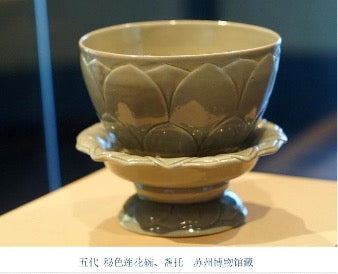

- The improved shape of tea cups in the Song Dynasty
People in the Song Dynasty popularized the way of tea drinking. At this time, the tea cups followed the style of the Five Dynasties. They were full and steady, with soft lines. The device type is simple and clear.
- Gaiwan was created and popular in Qing Dynasty
After the Ming Dynasty, the phenomenon of adding lids to tea cups and cup holders appeared. Why did it appear in this period?
The fundamental reason is the change of people's tea drinking habits. From a functional point of view, the changes in the tea method of Tang boil, Song point, Yuan transition, and Ming drinking made the tea set for drinking in pots and cups in Ming Dynasty become the mainstream.
The emergence of Gaiwan tea set is a new development based on tea bowls and tea cups under the background that the drinking method has been used until the Qing Dynasty.
In the reign of Kangxi in the Qing Dynasty, a bowl and a two-piece cover bowl were created and fired. Mr. Tian Zibing wrote in "History of Chinese Arts and Crafts": "Some of the ceramic shapes in the Kangxi period continued to use the old style, and some were transformed and developed. They are new varieties, some of which are full of originality, and a covered bowl was created in the late period, which is specially used for drinking tea."
The design of adding a lid on the bowl optimizes the drinking function of individual bowls, cups and cups. In addition to dustproof and heat preservation, pinch the bowl cover in the bowl and scrape lightly and heavily to adjust the thickness of the tea soup; do not remove the cover when drinking tea, and fine-tune it into a half-sheet and half-box state, the tea soup enters slowly, and the tea leaves in the bowl are blocked by the lid edge At the same time, the diameter of the lid is smaller than the diameter of the bowl. When the lid is placed in the bowl, it will not slip when drinking. When the bowl lid rises and falls, the tea soup is faintly visible. There is a wealth of information on tea tureen tea sets from the reign of Kangxi and Qianlong, especially the actual materials of the Qianlong period, which are not only considerable in quantity, but also innovative in materials and decoration.
Today, many museums name this kind of utensils Gaiwan in the process of data collation, but there is no official clear record of this naming in this period.
In Qianlong's "Records of Records", on November 25th of the eighteenth year of Qianlong, because the emperor admired Tang Ying's imperial poetry Sanqing tea cup made by order, he ordered "the leader Zhang Yu to deliver the decree: burn the imperial Make samples of poem tea hangers and then burn eight pairs. Four pairs of tea hangers with red flowers and red characters on white ground, and four pairs of tea hangers on white ground with blue and white characters. It is called "tea hanging".
In the later period, there were official drawings of porcelain made in the Qing Dynasty in the Forbidden City, which stated "the pattern of multicolored and eight auspicious covered bowls on powder ground" and "ten pairs of teacups and twenty pieces of covered bowls like this".
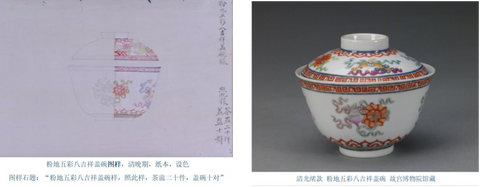
From this official drawing, it can be used as evidence to clarify the official name and shape of the "covered bowl" in a corresponding way between words and images. It can also be known that the Gaiwan tea set at this time has formed a fixed pattern in the official samples of the Qing Dynasty.
During this period, represented by the porcelain for the wedding of Tongzhi, the porcelain for Daya Zhai, and the porcelain for the Empress Dowager Cixi's longevity celebration, the number of covered bowl tea sets was quite large, and the production was exquisite and very particular. However, the shape and decoration are rigid, and the function is not optimized compared with the previous generation. It was not until the period of the Republic of China that the tureen had a new development.
At the same time, it can be seen from the style of gaiwan in the Qing Dynasty that most of the gaiwan tea sets in this period are two-piece tea sets with a lid and a bowl. in kit form.
- During the period of the Republic of China, the old brought forth the new, the three-piece bowl, cover and holder in the Republic of China
During the period of the Republic of China, while the traditional tureen tea set continued to be produced in the Qing Dynasty, Jingdezhen introduced the old and brought forth the new to produce a unique official cover, which may be regarded as a new variety of tureen tea set.
This is a kind of "tea bowl with a cover... It was more popular 10 years ago in the Republic of China, and it was mostly used by the government and rich people to drink tea, so it is called an official cover... People in ancient and modern times often call it a cover cylinder, which is mistaken for it. A vessel for holding things."
Later, around the tenth year of the Republic of China, a type of tureen tea set called "rice shells" was created, which consisted of three pieces: a cover, a bowl, and a holder. "Around the 10th year of the Republic of China, it was created in Jingdezhen. It was called the three-head rice shell. It was used as a tea drinking utensil. During the Republic of China, several best-selling utensils...Although there were covered bowls in the Qing Dynasty, there were no such three pieces. The upper class often used official covers to drink tea. , and the folks call it a slag bowl". That is to say, the three-piece gaiwan tea set we now call gaiwan was called "rice shell" in the period of the Republic of China.
The new development of the shape is mainly reflected in the addition of the bowl holder on the basis of the combination of the cover and the bowl, forming a fixed three-piece street. The function of the bowl holder is the same as that of the lamp holder from ancient times to the present. Compared with the two-piece tureen, the three-piece tureen has an anti-scalding function, which is easy to carry and handles tea spills.
Mr. Lu Xun once wrote in the article "Drinking Tea": "To drink good tea, you need to use a tureen. So I used a tureen. Sure enough, after brewing, the color is clear and sweet, slightly fragrant and slightly bitter. It is indeed a good tea. ."
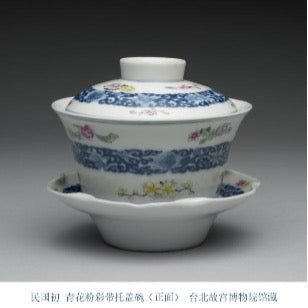
- The use of modern Gaiwan tea set
In modern tea events, there are two common usages of gaiwan. One is as the main brewing utensil, which is similar to the brewing function of a teapot. It is used in conjunction with tea utensils such as justice cups and tea cups. The tea soup is poured into the justice cup and then divided into the tea cups in turn. In Chaoshan Gongfu tea, the tea in the tureen is also poured directly into the tea cups.
Another way is to combine the functions of brewing and drinking, which is to drink the tea directly without leaving the gaiwan. This method of drinking tea is more common in the "gaiwan tea" in Chengdu and old teahouses in Beijing.
- Analysis of the shape and shape of the covered bowl
The shape of the gaiwan is not static. With the changes of the times and the development of society, the shape and shape of the gaiwan will be constantly adjusted according to the feedback during actual use. In this part, we will explain the shape of lid, bowl, holder
- cover
The lid is a detailed component of the gaiwan tea set, and an important part of the combination with the tea bowl. After the popular loose tea was brewed in the Qing Dynasty, the gaiwan, which has both aesthetic value and perfect function, gradually became popular. One very important reason is that the lid of the gaiwan is easy to clean. You don’t have to worry about the tea leaves clogging the hole when brewing tea with a pot. The lid is like the mechanism of the gaiwan tea set. Adjust the speed of the soup.
During the evolution of the design of the lid, there have been two shapes: one is that the diameter of the lid is larger than the diameter of the mouth of the bowl, and the lid covers the edge of the bowl, which is called "heaven and earth" style; this style of gaiwan, There is a disadvantage, the lid will be placed unstable when placed, causing it to slip. This type of gaiwan is not suitable for drinking utensils. From the perspective of use function, it is different from the gaiwan tea set we define and use.
The second type of "built-in" cover has been widely circulated and continues to be used to this day. The lid of the "built-in" tureen is not easy to slip off during actual use. Tea drinkers only need to leave a small hole on the lid to remove the tea dregs, and they can drink tea soup conveniently.
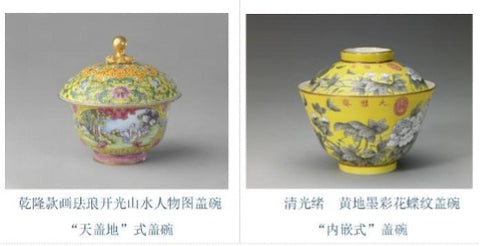
The cover button part of the bowl cover is also a place to give full play to creativity and highlight the shape. The cover button that is usually seen is in the shape of a ring foot, and there are also solid ones.
Heart geometry, petal shape and so on.
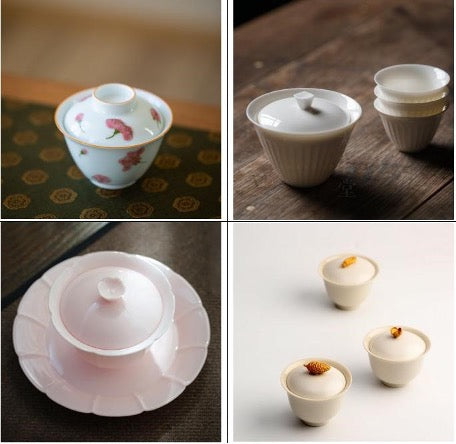
- Bowl
Bowls are the main utensils used to drink tea and make tea. They can be used alone, or they can be combined with a base and a lid to form a gaiwan tea set.
The shape of the bowls has a big mouth, a deep arc wall, and a small circle foot. The wide mouth of the bowl can directly and clearly observe the shape of the tea soup in the bowl, providing an excellent experience for tasting tea visually. The beautiful lines of the deep arc wall are conducive to expanding the capacity, and the small circle is enough to prevent scalding, which can prevent scalding hands and tabletops. On this basis, the parts of the bowl have changed again, mainly in two aspects: the edge of the mouth and the line of the bowl body.
The rim of the bowl can be divided into two types: straight mouth type and skimming mouth type.
The skimmer type is more common in everyday use. The characteristic of this type of bowl is that the diameter of the mouth of the bowl is slightly larger than that of the abdomen.
The diameter of the bowl is slightly curved outwards. Compared with the straight type, the curvature of the edge of the mouth and the lips are more gentle. When drinking tea, the tea will flow out more smoothly and the taste will be more comfortable.
This design feature can also prevent hands from being scalded when touching the gaiwan, and the outwardly curved part dissipates heat faster, making it more suitable for grasping pick.
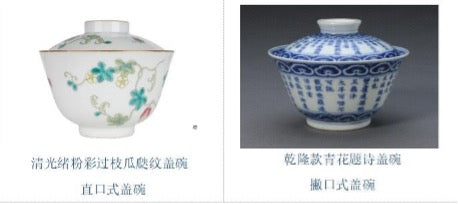
The curvature of the bowl body also has different shapes. For example, the line of the bowl wall has inner arcs, outer arcs, folded edges, folded waists, etc., and the circle feet near the bottom have curved inwards and inwards folds. There are many types of bowls, and the picture below only shows some of them.
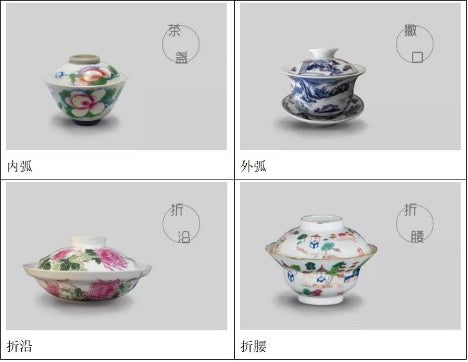
- Support
The design of the cup holder is a concentrated expression of "form follows function". The holder under the bowl (cup) can hold the cup. When drinking tea, hold the tea
The cup is convenient for passing and taking, and it can also prevent the person delivering the tea from directly touching the tea bowl, which not only avoids the problem of hot hands, but also shows respect and respect for the tea user.
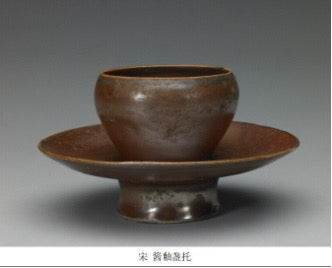
Up to the Ming and Qing Dynasties, the lamp holders of Gaotuokou still existed in this period, but there was a kind of holder that was quite different from the previous generation. This support is part of the gaiwan, the tall support mouth is gone, replaced by a circle of shallow crescent to fix the tea bowl.
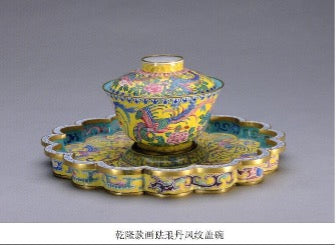
The picture above is a painted enamel phoenix bowl with a plate cover in the Qianlong period of the Qing Dynasty. The body and cover of the bowl are painted with a pattern of phoenix wearing a peony. , This is the enamel material of the imperial copper tire painting, the painting is exquisite and complicated, the color is rich and rich, showing the royal style.
For the two-piece tureen in the late Qing Dynasty, from the perspective of practical needs, people will add a support. This kind of support is called a tea boat because it is shaped like a boat, and there are also cross-shaped, petal-shaped, ruyi-shaped and so on. Tea boats are used to hold teacups, teapots and other utensils.
From the following text, you can get a glimpse of the role of the tea boat:
"Volume 5 of "Tu Feng Lu" by Gu Zhangsi in the Qing Dynasty: "The holders for the teacups of rich families are called tea boats. "
In the Qing Dynasty Jiyuansou's "Tao Ya", it is mentioned: "The cup holder is called a tea boat. The Ming system is like a boat. The Kangyong small wine cup is round and not empty. The Song kiln is empty. A little bit today It’s restrained and rather simple.”
It is also said in "Yinliuzhai Shuo Porcelain": "The cup holder is called the cup holder, and it is also called the tea boat. The Ming system is like a boat. In the early Qing Dynasty, it was also
However."

- "Harmony of heaven, earth and man" in the tureen——intrinsic sublimation
The literati endowed them with profound cultural connotations in the process of using the cup holders and tea bowls. Gaiwan is called "Three Talents"
"Bowl", "Sancai Cup", Sancai refers to: heaven, earth, and people. From "Yizhuan Xicixia", "There is a way of heaven, there is a way of life, there is a way of authenticity, and three talents and two, so six . Six is not it, the way of three talents. "The cover is "heaven" and the bowl is
"Human" is entrusted with "earth", implying the three talents of "heaven, earth, and man".
The saying "heaven, earth and man" first appeared in "Sun Tzu's Art of War": "Tao, weather, location, and harmony of people." From the design of the bowl,
Take a look, the lid is contained by the bowl, the bowl is contained by the lamp holder, and the whole utensil is included in the lamp holder, as if all things grow in the heaven and the earth... People are in the heaven and the earth, the sky contains it, feel the harmony between heaven, earth and people realm of aesthetics.
In "Laozi", there is "man follows the earth, the earth follows the sky, the sky follows the Tao, and the Tao follows the nature" discusses the relationship between the heaven, the earth, man and the natural way. Take "Tao" as the law, and "Tao" is purely natural, and takes its own original appearance as the law. In different time and space of existence, people of different "life forms" have different knowledge and understanding of "Tao". This is the so-called "horizontally viewed as mountains and laterally as peaks, with different heights and heights." People with different heights and "life forms" have different wisdom, living spaces and environments, and the way of existence of "Tao".
The integration of man and nature is the main idea of Taoism. In "Zhuangzi", it bluntly says "heaven, earth and man are in harmony". Put people between heaven and earth, and put people in a "harmonious" and "peaceful" world. What it expounds is a kind of thought, and it should be a kind of realm. "Heaven, Earth and Human Harmony" has been passed down from ancient times to the present, adheres to the "golden mean", conforms to social development, and builds "harmony" and "peace". It also has the meaning of "time, place, and harmony". Holding the "Sancai Cup" in his hand, the bowl is filled with grass and trees, which also fits the meaning of the word "tea" "people are among the grass and trees, who can not drink tea". Between the vegetation, the heaven and the earth, look for a natural environment where people and the heaven, earth and vegetation are in harmony.
- The choice and use skills of the cover bowl
In this part, we briefly introduce how to choose a tureen that suits you, and how to use the tureen.
Gaiwan is known as the "universal tea set" in the tea world. You can brew green tea, black tea, yellow tea, white tea, Pu'er tea, black tea, and even the scented tea you want with ease. Personal control can truly be unfettered. Therefore, the biggest advantage of brewing with a tureen is that you can control the concentration and taste of the tea soup as you like, and you can brew the tea soup you want. It is convenient and practical. Using the tureen well is like getting a manual driving license.
- How to choose a tureen that suits you
The shape of the tureen is generally the same, and the combination elements are nothing more than "cover, bowl, and holder". However, the shape, color and material of the tureen can be varied.
According to the different glaze colors, there are plant ash, sky blue, fat white, shadow blue, etc.; according to the different decorations, there are also hand-painted flowers and birds, auspicious clouds, plum, orchid, bamboo and chrysanthemum, etc.
According to different materials, there are porcelain, pottery, purple sand, glass and so on; in porcelain, there are also white porcelain, celadon, colored porcelain, black porcelain and so on.
In terms of capacity: the size of the tureen is: 100ML, 110ML, 120ML, 150ML, 300ML, etc. When choosing the capacity, it is necessary to choose the appropriate tureen according to the proportion of tea and water, and also consider the number of people drinking tea. So how to choose the tureen that suits you? The most important thing is to know yourself.
Do you usually make tea? Is it soaked every day or once a week, or even once a month? Are you an old tea drinker with a certain tea age or a novice who just learned how to make tea, are you familiar enough with using gaiwan?
As a novice Xiaobai, looking at the brewing of all teas, it is recommended to use a white porcelain tureen with a skimming lip. Because the texture of white porcelain is smooth and delicate. The smooth white porcelain is not only convenient to observe the color of the soup, but also easy to clean. The skimming design is convenient for water discharge, and it is also more convenient to handle. In terms of size, just choose the size that suits your fingers. For beginners or girls with weak wrists, it is not recommended to choose thick-walled and heavy-duty tureen.
As for other patterns and decorations, just choose the one that suits your eyes.

- How to use the gaiwan
Now there are several ways to use tureen, we only introduce the use of Junmei Chinese tureen.
First of all, when taking it, select the "point grasping method". "Point" means pointing the button of the cup lid with your index finger, and "grasp" means grasping the edge of the cup with your index finger and thumb (into a diameter).
There are three things to note about this approach:
Point 1: The opening angle of the cover should be appropriate. If it is too small, it will lead to unsmooth water outlet, and the time of holding the tureen will be prolonged. If it is too large, the fine leaves will fall off. Escaping steam is easy to burn your hands.
The second point: Press the cover button with the index finger evenly, otherwise, if the force is biased to one side, the cover on the side close to the palm of the hand may be lifted, and the steam that emerges will burn your hands and even make the cover slip off.
The third point: pay attention to the angle of the water. Use the flip of the wrist to make the water outlet vertically downward, and the smooth water outlet is in the shape of a smooth waterfall.
